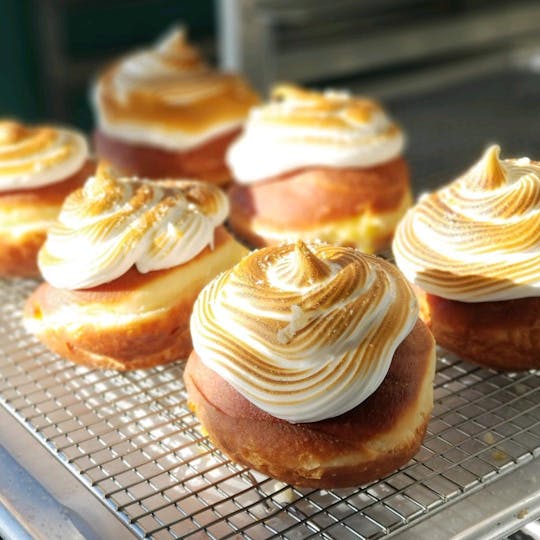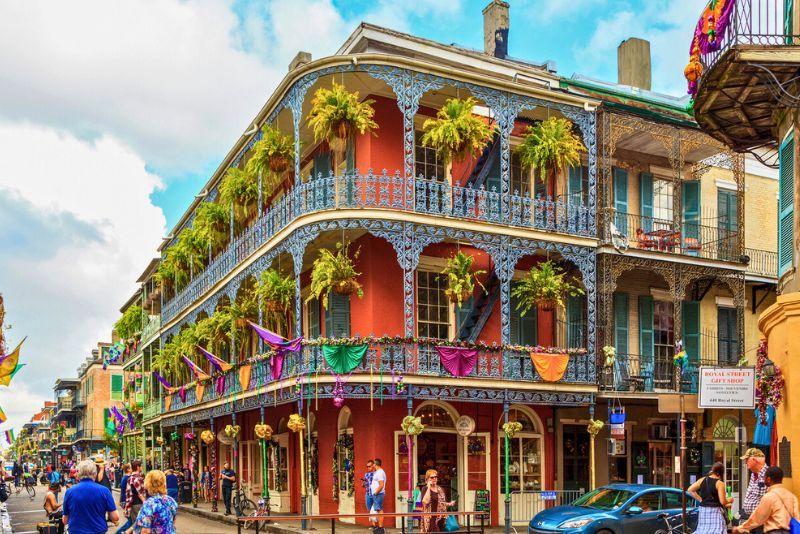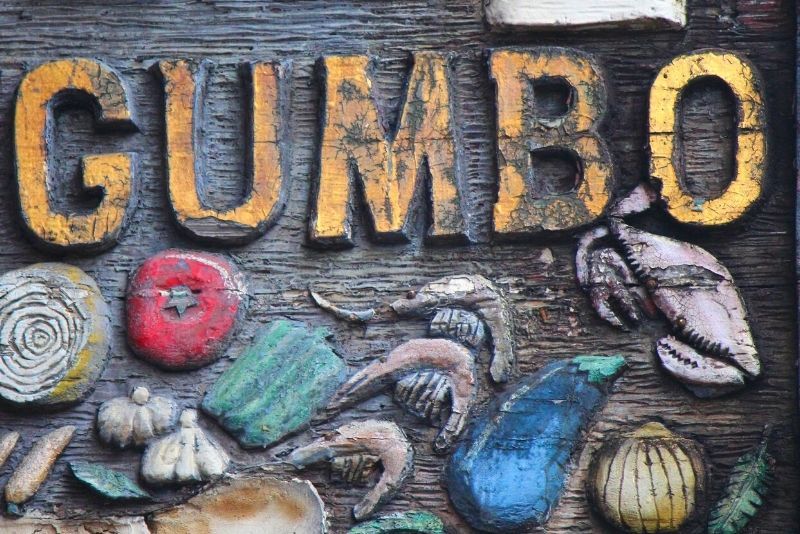Food Tours in New Orleans
New Orleans, a melting pot of cultures, boasts a vibrant food scene deeply rooted in Creole and Cajun traditions. Influences from French, Spanish, African, and Native American heritage fuse in iconic dishes like gumbo, jambalaya, and étouffée.
Seafood plays a starring role on the food scene, with crawfish, shrimp, and oysters featured prominently. The city's culinary landscape is intertwined with a lively music scene, epitomized by jazz, and festive traditions like Mardi Gras.
New Orleans, a melting pot of cultures, boasts a vibrant food scene deeply rooted in Creole and Cajun traditions. Influences from French, Spanish, African, and Native American heritage fuse in iconic dishes like gumbo, jambalaya, and étouffée.
Seafood plays a starring role on the food scene, with crawfish, shrimp, and oysters featured prominently. The city's culinary landscape is intertwined with a lively music scene, epitomized by jazz, and festive traditions like Mardi Gras.

(0/24) checking Musement...
New Orleans, a melting pot of cultures, boasts a vibrant food scene deeply rooted in Creole and Cajun traditions. Influences from French, Spanish, African, and Native American heritage fuse in iconic dishes like gumbo, jambalaya, and étouffée.
Seafood plays a starring role on the food scene, with crawfish, shrimp, and oysters featured prominently. The city's culinary landscape is intertwined with a lively music scene, epitomized by jazz, and festive traditions like Mardi Gras.
New Orleans food tours allow you to appreciate the local cuisine, which is renowned for its unique blend of flavors, reflecting the city's diverse cultural heritage.

Here's a helpful guide on food tours, one of the most fulfilling gastronomic experiences in New Orleans.
What are the best food tours in New Orleans?
Each of New Orleans districts has its own culinary appeal, but no matter where you indulge in the food and drinks of this festive city, you are sure to have an unforgettable experience.
While most tours are operated on a small group basis, you may have the option to upgrade to a private tour. Here are just a few of the most popular food tours you can choose from:
French Quarter walking tours
Guided foodie walking tours in the French Quarter are typically offered on a small group basis, and you will join your guide to explore the flavors of New Orleans cuisine.
On this tour you can expect to sample between 5 and 10 different foods, depending on your itinerary. Many tours begin with a tasty boudin beignet, while at the French Market, local dishes such as Cajun-style gumbo are on the menu.
The tour includes tastings of Louisiana originals such as po-boys and Muffuletta and usually end on a sweet note.
New Orleans Cocktail and Food history Tour
New Orleans is also known for its cocktail culture, with famous drinks like the Sazerac, Hurricane, and Ramos Gin Fizz originating from the city. On a cocktail and food history tour, your group will enjoy a variety of authentic food tastings at iconic eateries, combined with a carefully selected range of local cocktails.
The tour includes details of Louisiana’s colonial history, the Cajun influence on the region’s food, and a chance to sample house specialties and signature drinks at venues such as Napoleon House, Dickie Brennan’s Tableau and the Cane and Table.
You can also choose to book this tour on a private basis for your group.
New Orleans: Garden District food, drinks and history tour

A Garden’s District food tours highlights the history of food in New Orleans. Along with enjoying Creole and Cajun specialties, your tour visits sites such as the laFayette cemetery, the oak trees and historic mansions in the district and the chance to stop and shop at local stores and co-ops.
Your guide will escort your leisurely walk through this particularly appealing part of New Orleans and ensure that you learn more about the city’s history and heritage as you taste the delicious treats and refreshments available.
New Orleans: Culinary experience and Cocktail tour
For a truly immersive experience, you can book a tour that combines a cocktail tour of the French Quarter with a cooking class with a professional chef. The demonstration cooking experience is followed by a tasting of classics such as gumbo, jambalaya and pralines.
The cocktail tour begins after the cooking activity and includes a guided walking tour through the fascinating streets of the French Quarter, where you will stop at historic bars to sample quintessential New Orleans cocktails. Additional drinks and snacks are available on your own account.
Southern Food and Beverage Museum tour
The Southern Food and Beverage museum provides a food experience of a different kind. You can embark on a self-guided museum tour to enlighten yourself about the cultures that blend to create the South’s culinary flavors.
At the Museum of the American cocktail you’ll find out more about the early days of absinthe and you can enjoy lunch or a cocktail at the famous Toups South. This ticket price includes access to the Southern Food and Beverage museum’s weekend programs, tastings and classes.
What kind of food will you eat?

In the French Quarter and Garden District, you can expect to visit some iconic restaurants and markets that serve Cajun and Creole cuisine. Some of the local dishes you might encounter on the tour include:
- Creole cuisine, a sophisticated blend of French, Spanish, African, and Native American influences. Classic Creole dishes include gumbo, jambalaya, and étouffée.
- Cajun food is rustic and hearty, originating from the French-speaking Acadians of Louisiana. Popular Cajun dishes include boudin (a type of sausage), crawfish étouffée, and blackened fish.
- Seafood. Given its location along the Gulf of Mexico, New Orleans boasts an abundance of fresh seafood. Shrimp, oysters, crawfish, and crab are staples in many dishes. The city is famous for its oyster bars and seafood boils.
- Po'boys and Muffulettas are two iconic sandwiches of New Orleans. The po'boy is a traditional sub-style sandwich filled with meat or fried seafood, while the muffuletta is a round sandwich filled with Italian meats, cheeses, and olive salad.
- Beignets, square pieces of dough fried and covered with powdered sugar, are a New Orleans staple, often enjoyed with café au lait (coffee with milk). They are particularly associated with the city's French Quarter.
Which places will you visit?
Each different tour visits the district or venues specified. As most tours are walking experiences, you will not only get to taste New Orleans’ cuisine, but do some sightseeing and learn more of the city’s history and traditions.
The New Orleans Culinary experience and Cocktail tours include the cooking demonstration class and a guided walking tour in the French district. The Southern Food and Beverage museum tour includes access to the Museum of the American and you can stop for lunch or a cocktail at Toups South nearby.
How much should you expect to pay for food tours in New Orleans?
French Quarter walking food tours typically cost from US$80 per person regardless of age, while New Orleans cocktail and food history tours are for adults only and start from US$140 per person.
A Garden District food, drinks and history tour in New Orleans costs from US$90 per adult participating. Youths aged 17 years and younger will pay a discounted rate of around US$70 each.
New Orleans’ Culinary experiences with cocktail tours are adults only experiences and start from US$105 per person.
A Southern Food and Beverage Museum tour ticket costs from US$12 per adult. Seniors over the age of 65 years and students and military members pay only US$9. Children under the age of 18 can enter for free when accompanied by an adult.
If you would prefer a private tour that is customized to your interests and culinary tastes, you can expect to pay around US$200 per person, with a minimum of 2 participants required for a confirmed private food tour. Private groups usually accommodate up to 10 guests.
What is included as part of the food tour?
Each tour has its own route with several stops for food and sometimes cocktail tastings. The number of samplings and tastings varies depending on the tour chosen.
New Orleans’ Culinary experiences and cocktail tours include a cooking demonstration class, a guided walking tour, generous samplings and cocktails as specified.
Tickets to the Southern Food and Beverage Museum includes access to the Museum of the American cocktail and access to the museum’s weekend programs, tastings and classes
Where do they normally start?
French Quarter food tours will each have their own meeting point in the area. Garden District tours often commence from a meeting point near Coliseum Street. Culinary experiences begin at the New Orleans School of Cooking while the museum is located at Oretha Castle Haley Boulevard. Private tours may offer a hotel pickup and drop off.
How long do they typically last?
Most food tours have a duration of around 3 hours, although 2-hour and 4-hour tours are also offered by some tour operators.
Are they wheelchair friendly?
The Southern Food and Beverage Museum is wheelchair accessible, but no service animals are permitted. Other tours are walking experiences and take place on uneven surfaces, making them unsuitable for wheelchairs or for people with other mobility difficulties.
What time of year should you book a food tour in New Orleans?
The best time for a food tour in New Orleans is typically in the spring (March to April) or fall (October to November), when the weather is mild and humidity is lower, making it comfortable for exploring.
These periods also avoid the peak tourist seasons of Mardi Gras and the Jazz & Heritage Festival, ensuring fewer crowds. However, aligning your visit with specific food-related events or festivals can enhance the culinary experience.
Off-peak times, like weekdays or non-festival periods, offer a more relaxed atmosphere with less crowded restaurants. The holiday season also presents a unique, festive experience, though it's busier and requires advance planning. Ultimately, the best time depends on your preferences for weather, crowds, and cultural experiences.
Travel tips
- Respect local etiquette. Be respectful of local customs and traditions. This includes being polite and patient with service staff, as the city can get very busy, especially during peak seasons.
- Make reservations when possible: For popular restaurants, it's wise to book a table in advance, especially during peak tourist seasons or around major festivals and events.
- Leave room for street food and markets: Don't overlook food trucks, street food, and local markets. They often offer some of the most authentic and delicious culinary experiences in the city.
